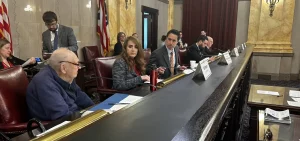News
Controversy is expected at panel to determine the language for issues on Ohio’s November ballot
By: Jo Ingles | Statehouse News Bureau
Posted on:
COLUMBUS, Ohio (Statehouse News Bureau) — The Ohio Ballot Board, the panel that determines the language voters see on their ballots, meets Thursday afternoon, and those involved in the process suspect there will likely be some controversy over the board’s actions, especially about the way the reproductive rights constitutional amendment is worded.

“Our language that’s in this amendment is very clear, it’s concise, it’s only 204 words,” Mann said.
But Mike Gonidakis, president of Ohio Right to Life, said he thinks the board should come up with different language.
“There is no law that says you just rubber stamp what the attorney general approved,” Gonidakis said.
While Gonidakis said the board should come up with its own language, he won’t specify what that should look like.
Mann said he’s concerned the board will try to inject some controversial or inaccurate language that has been used in the past by opponents of the proposed amendment.
“We’ve seen the personal political biases of some members of the ballot board and so we know the sort of tricks that they pull,” Mann said.
Mann and others who are backing the proposed amendment were not happy when the ballot board earlier this year adopted the initial language for the ballot petitions. A challenge was brought before the Ohio Supreme Court and it later ruled the board had to make some changes to the initial language. Mann said if the ballot board gets it wrong this time, his side will likely go to the court once again.
For his part, Gonidakis said he trusts the bipartisan ballot board to get it right.
“It’s the ballot board’s discretion and power to do what they think is best,” Gonidakis said.
At the same meeting, the board will also determine language for another issue — a proposed law that voters will decide that, if passed, could legalize marijuana for Ohioans 21 and over.
Tom Haren, spokesman for the Committee to Regulate Marijuana Like Alcohol, the group behind the initiative, said they are looking forward to going before the ballot board to receive a “fair and accurate representation of that proposal.” And he said that summary should make several points clear.
“We think it would inform voters that our proposal is to regulate the sale of marijuana for adults in Ohio, to impose a rigorous regulatory framework, general tax revenue for the state and to ensure that consumers have an alternative to the elicit market.”
Unlike backers of the abortion amendment, Haren said it would be hard to use the language of the initiative on the ballot because it is much longer due to the fact that it is a law that would go into the Ohio Revised code.
The board will also decide the order in which both measures will appear on the statewide ballot in November.

